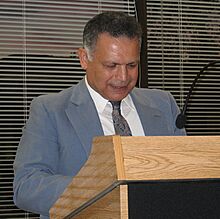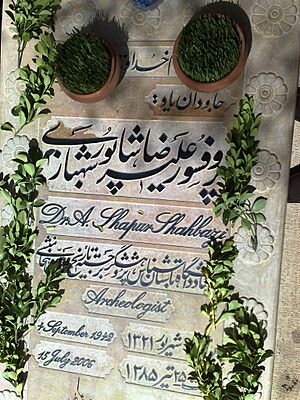Alireza Shapour Shahbazi facts for kids
Quick facts for kids
Ali Reza Shapour Shahbazi
(Persian: علیرضا شاپور شهبازی) |
|
|---|---|
 |
|
| Born | September 4, 1942 |
| Died | July 15, 2006 (aged 63) |
| Resting place | Hafezieh |
| Nationality | Iranian |
| Scientific career | |
| Fields | School of Oriental and African Studies |
| Institutions | Shiraz University University of Göttingen University of Tehran Harvard University Columbia University |
Alireza Shapour Shahbazi (born September 4, 1942, in Shiraz, Iran – died July 15, 2006, in Walla Walla, Washington) was a very important Iranian expert. He was a famous archaeologist, which means he studied old human history by digging up ancient sites. He was also an Iranologist, someone who studies the history, culture, and languages of Iran.
Shahbazi was known around the world for his knowledge of the Achaemenid Empire, an ancient Persian empire. He earned degrees in archaeology from the School of Oriental and African Studies (SOAS) and the University of London. He taught at many famous universities, including Harvard University and Columbia University.
In 1974, he started the Institute of Achaemenid Research in Persepolis, a famous ancient city in Iran. After the Islamic revolution in Iran, he moved to the United States. There, he continued to teach history at Eastern Oregon University. He also helped create the Encyclopædia Iranica, a huge collection of information about Iranian history and culture. He wrote many articles for it about the Achaemenid, Arsacid, and Sasanian periods of Iran.
Shahbazi wrote many important books and articles about ancient history, especially about the Achaemenid, Sasanian, and Islamic periods. He wrote in English, German, French, and Persian. He passed away on July 15, 2006, after a long illness. He was buried in Shiraz, near the Tomb of Hafez.
Contents
A Life Dedicated to Ancient Iran
Alireza Shapour Shahbazi spent his life exploring and teaching about ancient Iran. He held many important jobs and helped us understand more about the past.
His Academic Journey
- 1968–1971: He started as an instructor at Shiraz University.
- 1973–1974: He became a curator at the Archaeological Museum in Tehran and taught at the University of Tehran.
- 1974–1979: He founded and directed the Archaeological Institute at Persepolis. This was a big step for studying the Achaemenid Empire.
- 1979–1984: He was a visiting scholar at Columbia University and did research in Germany. He also taught Iranian civilization at Harvard University.
- 1985–2005: He became a professor of history at Eastern Oregon University.
- 2002–2003: He served as an associate editor for the Encyclopædia Iranica, a major project to document Iranian history.
Recognized for His Work
Shahbazi received several awards for his dedication and contributions to history:
- 1970: He won the Book of the Year Prize for his book on Cyrus the Great.
- 1980–1983: He received the Alexander von Humboldt Fellowship in West Germany, a prestigious award for researchers.
- 1995: He was recognized as an Outstanding Faculty Advisor by the Phi Alpha Theta History Honour Society.
- 2005: He received the Distinguished Faculty award from Eastern Oregon University.
- 2005: He was honored with the Distinguished Career Achievement award by the Middle East Study Association.
Important Books and Discoveries
Alireza Shapour Shahbazi wrote many books and articles that are still used by students and experts today. His work helped shed light on the ancient history of Iran.
Key Books He Wrote
He wrote several books about ancient Persian rulers and sites, including:
- Cyrus the Great: Founder of the Persian Empire (1970)
- Darius the Great (1971)
- A Persian Prince: Cyrus the Younger (1971)
- Illustrated Description of Naqš-i Rustam (1978)
- Persepolis Illustrated (1976)
- Ferdows: A Critical Biography (1991)
- Passargadae. A Comprehensive and Illustrated Guide (2000)
- The Authoritative Guide to Persepolis (2004)
Working with Others
Shahbazi also worked with other scholars on important projects:
- He was an assistant and associate editor for the Encyclopædia Iranica.
- He contributed to The Splendour of Iran, Vol. I: Ancient Times, a book about Iran's ancient art and history.
Articles and Research
He wrote many articles for academic journals and encyclopedias, covering a wide range of topics about ancient Iran, including:
- The Achaemenid Empire and its symbols.
- The Sasanian Empire and its art.
- The history of Iranian historiography (how history was written in Iran).
- Detailed studies of ancient sites like Persepolis and Naqš-i Rustam.
- Articles for the Encyclopædia Iranica on topics like "Army in Ancient Iran," "Capital Cities," "Coronation in Pre-Islamic Iran," and "Flags of Persia."
Documentaries He Worked On
Shahbazi also shared his knowledge through documentaries, helping a wider audience learn about ancient Iran:
- 1976: "Crossroad of Civilization" (BBC)
- 1999: "Heritage of Iran" (Seda va Sima)
- 2000: "Spartans at the Gate" (Discovery Channel and BBC)
- 2002: "Persepolis: A New Look" (Sunrise Production)
- 2003: "Persepolis Regained" (BBC Radio)
See also
- Iranology
- Achaemenid Empire
Other notable Iranologists:
- Abdolhossein Zarrinkoub
- Richard N. Frye
- Ehsan Yarshater
- Ahmad Tafazzoli
- Mehrdad Bahar
- Parviz Varjavand


